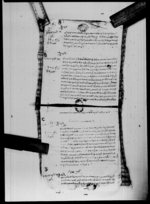A copy of a lālamohara from King Rājendra appointing Bhīmasena Mājhī to manage Dasaĩ worship at Arghākoṭa (VS 1892)
ID: K_0017_0001B
Edited and
translated by Astrid Zotter
in collaboration with
Pabitra Bajracharya
Created: 2022-05-24;
Last modified: 2023-02-16
For the metadata of the document, click here
The accompanying edition, translation/synopsis and/or commentary are available under the terms of the Creative Commons Attribution-ShareAlike 4.0 International License
Abstract
The lālamohara from King Rājendra of which this is a copy appoints Bhīmasena Mājhī to manage the worship of Śrī Devī at Arghākoṭa during both Dasaĩ festivals alone instead of together with Punai Jaisī. As the latter had started a quarrel, with consequences for the proper performance of rituals, he is henceforth set aside and a new regulation (bandeja) is fixed in place to ensure that the festivals run their course as before and in keeping with the written records.Diplomatic edition
[67]
1⟪नं९१⟫1⟪पो१८१।९सी३४⟫1⟪हे∙ना∙रा∙वीस्नु∙2भं∙नौहर्ष⟫1[Unknown seal]1आगेभीमसेनमाझीकेअर्घाकोट्का∙
2आउन्यासराजामलेचैत्रादसैगर्नु∙गुठरह्याकोमौलावोट्षेत२को∙ऊ
3वजनीलेवडादसैगैर∙नीत्यनैमीत्यपुजागर्नुसवुजपल्टन[?]काजागी
4रमादरीय़ाकोकुम्हालटारीकोठेकरुपैय़ा२२॥सालवसालजागीरदार
5लाईवुझाईदसैगर्न्यालेषेतकोचलनगर्नु∙भनीतेरानाउमार∙पुनैजैसी∙
6कानाउमामोहरगरीवक्स्याकोहोपुनैजैसीलेषीचँलागरी∙दीदावीधीपुर्व
7ककोपाठ∙पुजाषंडीतहुनगय़ोभनीतआईहाम्रोहजुरमावींती∙गर्दाअघी
8भय़ाकोमोहरहानीपुनैजैसीलाईवाहेक्गरीतेरानाऊमामोहरगरीवक्स्यौ
9आफ्नाषातीरजामासंगहाम्रोजयेमनाईश्रीदेवीकास्थानमापर्वपर्वमा
10परापुर्वदेषीकोवीधीवीधानलेव़लीपुजापाठगरीसेषरह्याकोषानु∙
11अघीदेषीचलीआय़ाकोश्रेस्तासंगकाजकाम∙माचाहीय़ाकोसराजा
12मरांगावोका∙ताहाकाथरीभलाआदमीरैतीहरुलेदीनुकाममालाग्या
13कोमालकोमोलअघीदेषीचलीआय़ाकाश्रेस्तासंगलीनुभंन्यावंदेज1[Unknown seal]1[Unknown seal]
[68]
1⟪६८नं⟫14वाधीवक्स्यौईतीसम्वत१८९२सालवैसाषसुदी१०रोज३¯¯¯ ¯¯¯ ¯¯¯ ¯¯¯ ¯¯¯ ¯¯¯ ¯¯¯ ¯¯¯
Translation
[67]
[In the upper margin:]
no. 911
[In the left margin:]
Bundle (po[kā]) 181|9 sī 342
The one who watched [was] the nā[yaba]rā[iṭara]Vīsnu.3
The one who said [was] the nau[sindā]Harṣa.
[Main text:]
Āge: To Bhīmasena Mājhī
A mohara was issued in your name and in Punai Jaisī's name,4 stating: "Perform the Caite Dasaĩ (text: caitrā dasai) at the temple of Śrī Devī of Arghākoṭ with accessories (sarjāma) coming from the local administrator (amālī). Perform all regular and occasional worship [during] Baḍā Dasaĩ with the produce of 2 khetas [of land at] Maulāboṭ that exist as trust land (guṭha). Submit annually to the jāgiradāras 22 rupees [raised under] contract (ṭheka) [on land yielding] rainfed paddy (ṭārī)[cultivated by] the Kumāles5 —[land] registered as remuneration (jāgira) for the Sabuja Palṭana—6 and keep a written account of those who perform the Dasaĩ [blood sacrifices]7 ." As you came and submitted a petition us, stating: "Punai Jaisī has engaged in quarrels (khīcãlā for khicolā), so that the prescribed [method of] recitation and worship has become compromised," we annul the mohara that was [issued] before, set Punai Jaisī aside and issue a mohara in your name. We establish the following regulation (bandeja): Being conscious of your duties, celebrate our triumphs, perform the blood sacrifices, recitations and worship rituals on festival days according to the rules that have been [in effect] since olden times at the temple of Śrī Devī and enjoy what remains [after expenses have been covered]. The accessories, he-buffaloes [and] he-goats that are needed for the taks are to be given by the clan elders (tharī), local notables (bhalādmi) and ryots, in keeping with the account book (srestā) that has been traditionally kept from earlier on. Payments for the material that goes into the rituals are to be taken in keeping with the accounts (srestā) that have been traditionally kept from earlier on.
[Unknown seal]8
[Unknown seal]9
[68]
[In the upper left margin:]
[p.] no. 6810
Tuesday, the 10th of the bright fortnight of Vaiśākha in the [Vikrama] era year 1892 (1835 CE).11
Commentary
The document concerns the management of the Dasaĩ rituals performed at Arghākoṭ, the capital of the former kingdom of Arghā (one of the Caubīsī Rājyas), which had been conquered by the Gorkhālīs in 1786.12 Appointments to the post of manager are known from both earlier and later years (for an overview, see Commentary to K_0031_0019C). The present document seems to be directly referring to a lālamohara that had appointed Bhīmasena Mājhī together with Punai Jaisī about a year before the present one, in the month of Phālguṇa in VS 1890 (1834 CE, K_0003_0036C), following a complaint against a still earlier manager of the rituals. The present document refers to the regulations fixed in place in K_0003_0036C, though largely not by directly quoting them but rather by paraphrasing their content. Moreover, it changes their sequence. Thus, while in K_0003_0036C first comes the rule regulating how provisions for the autumnal Dasaĩ are to be managed, here the spring Dasaĩ is mentioned first. Moreover, the phrase used in the present document in relation to the spring Dasaĩ (amālīvāṭa āunyā sarājāmale caitrā dasai garnu) almost exactly tallies with what is said in K_0003_0036C (amālīvāṭa āunyā sarajāmale caityā dasai garnu), but the rule for the autumnal Dasaĩ is formulated differently; while K_0003_0036C stipulates that the rituals are to be performed with the produce and the ghiu khāne levy from 2 khetas at Maulāboṭa as before, the present document calls this land a guṭha and does not mention the ghiu khāne revenue from it. The largest deviation is, however, is found in the rules concerning the Sabuja Palṭana—the military company that had jāgira land holdings in the area and possibly had been in charge of the official blood sacrifices at the koṭa—and their right to the 22 rupees of revenue contracted on the land. According to the earlier document, the money had to be submitted annually to the registration office (daphadarakhānā) of the Sabuja Palṭana, not—as stated in the present document—to the jāgiradāras themselves. Moreover, K_0003_0036C mentions that the land in question had been newly cultivated by one Jiūdhara Mājhī. No such information appears in the present document. Finally, the earlier phrase maulāmā ḍasai garnyā lekhetko calana garnu (or: maulāmā ḍasai garnyāle khetko calana garnu) no longer contains the word maulāmā, which blurs understanding of what the actual rule intended (see note on this phrase above). Interestingly, the new bandeja fixed by the present document does not restate the details of the previous bandeja, but only refers to the rules (including written records) that had been in place before.
It seems that management of the provisions for the Dasaĩ rituals at Arghā had been riven by constant conflicts between different actors involved. For more on these conflicts in later times, see Ramirez 1993, Ramirez 1996.

